Android12指纹框架完全解析
Posted 梦想全栈程序猿
tags:
篇首语:本文由小常识网(cha138.com)小编为大家整理,主要介绍了Android12指纹框架完全解析相关的知识,希望对你有一定的参考价值。
前言:自从android6.0开始Google官方出了标准的Android指纹框架,结束了各家指纹厂商各自为政的局面,推动了电容指纹在Android的发展;自从2017年新思的屏下指纹方案横空出世,后边汇顶等指纹厂商跟进,Android 屏下指纹方案技术层出不穷;不过在Android12开始,Google 更新了Android指纹框架,添加了屏下指纹的支持,本文章会一一讲解新的指纹框架,也是为记录自己的学习过程
注:目前指纹框架代码修改比较大,笔者手上是android_12.0.0_r34, 使用的测试手机是pixel 3xl
一.指纹的启动过程

1.init 进程解析init.rc文件启动HAL层指纹service
init: Setting property 'ro.build.fingerprint' to 'Android/aosp_crosshatch/crosshatch:12/SP1A.210812.016.C2/eng.20221212.113415:userdebug/test-keys'
init: Parsing file /vendor/etc/init/android.hardware.biometrics.fingerprint@2.2-service.fpc.rc...
从笔者的手机log输出中,可以看到指纹的init 文件是vendor/etc/init/android.hardware.biometrics.fingerprint@2.2-service.fpc.rc
通过指纹的init.rc 文件,启动/vendor/bin/hw/路径下面的android.hardware.biometrics.fingerprint@2.1-service.fpc可执行文件

2.执行HAL层指纹serivce并通知TEE环境Load指纹TA

从上面的log中可以看到两个关键点
pid-1297 D fpc fingerprint hwbinder service startingQSEECOM: qseecom_load_app: App with id 2 (fpctzappfingerprint) now loaded可以看出,启动HAL层指纹service, 调用指纹Hal 层代码,通知TEE去load名字叫
fpctzappfingerprint 的程序
注意:这里先暂时跳过HAL层的讲解
总结:
- init 进程启动的时候,解析了android.hardware.biometrics.fingerprint@2.2-service.fpc.rc文件,通过此文件启动HAL 指纹Service
- 指纹Service在启动过程中,回去通知TEE去load名字叫fpctzappfingerprint 的程序
3.启动Framework层指纹service
SystemServerTiming system_process I StartFingerprintSensor
SystemServiceManager system_process I Starting com.android.server.biometrics.sensors.fingerprint.Fin...
FintgerprintService system_process E FingerprintService
FintgerprintService system_process E onStart
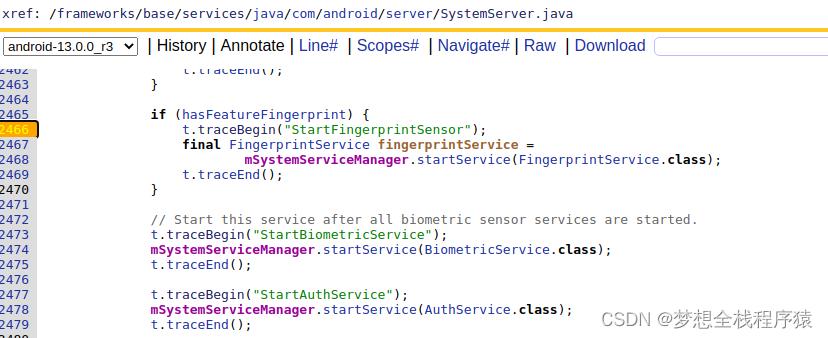
SystemServer.java文件中的2466行到2478行,分别启动了FingerprintService,BiometricService跟
AuthService这三个Framework层的系统将服务;将会调用这三个系统级服务的构造函数跟oStart方法


FingerprintService的构造函数,创建了一个FingerprintServiceWrapper类的对象,然后FingerprintService的onStart方法,调用了publishBinderService方法
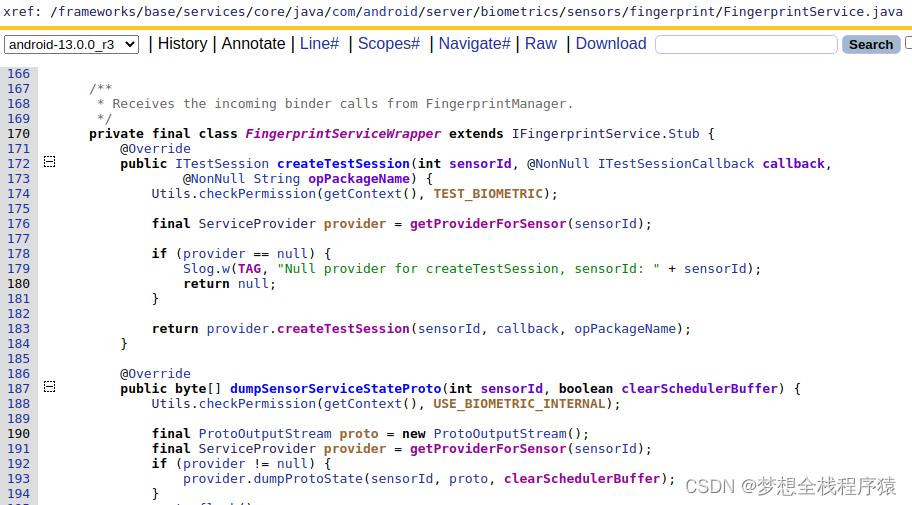
FingerprintServiceWrapper继承了IFingerprintService.Stub方法,并通过上面的publishBinderService方法;启动了这个FingerprintServiceWrapper 远程服务端,
通过168行的注释,知道其客户端就是FingerprintManager,后边可以验证是否正确
/**
* Receives the incoming binder calls from FingerprintManager.
*/总结:
- SystemServer 调用FingerprintService的构造函数跟onStart方法
- FingerprintService在其构造函数创建了一个FingerprintServiceWrapper类的对象
这个类是一个Binder的远程服务器 - FingerprintService在onStart方法中,启动了FingerprintServiceWrapper这个远处服务器
二.Framework指纹服务连接HAL层指纹服务
上面已经讲了,指纹从开机启动到Framework的启动流程;Hal层指纹service跟Framework指纹service都已经各自启动了;但是目前还没有牵桥搭线

FingeprintintService I FingerprintServiceWrapper registerAuthenticators
经过无数的Log跟踪打印之后,发现了FingerprintServiceWrapper的registerAuthenticators方法会被调用
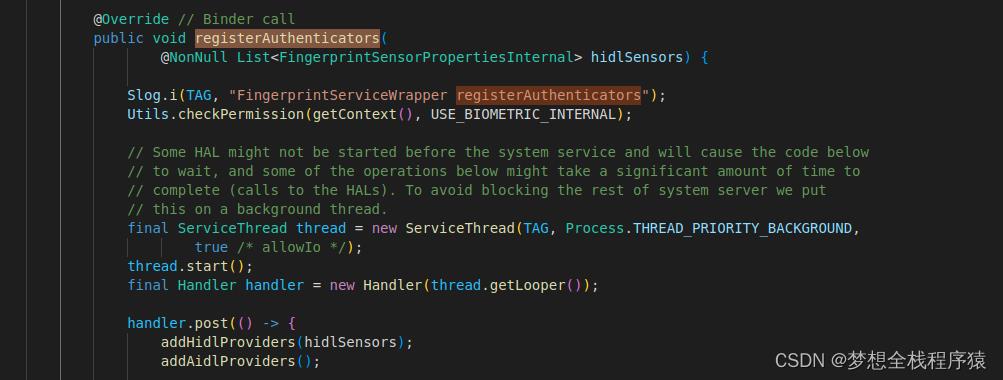
然后通过代码搜索发现其会被AuthService.java的registerAuthenticators方法调用
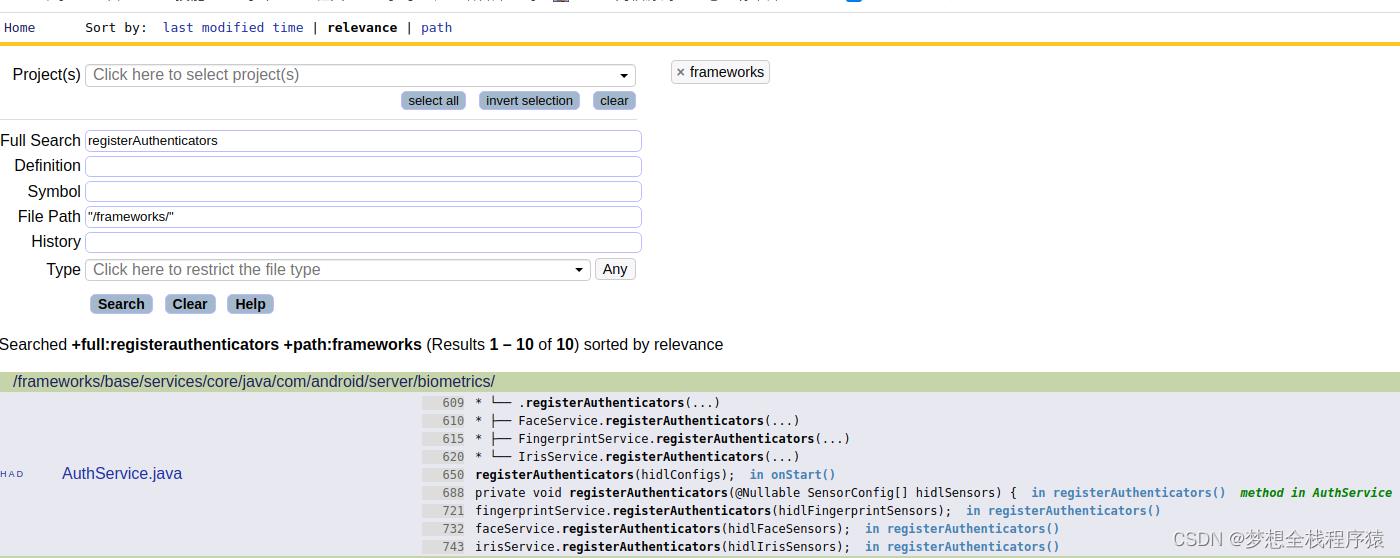
进入到AuthService.java文件中,registerAuthenticators方法如下
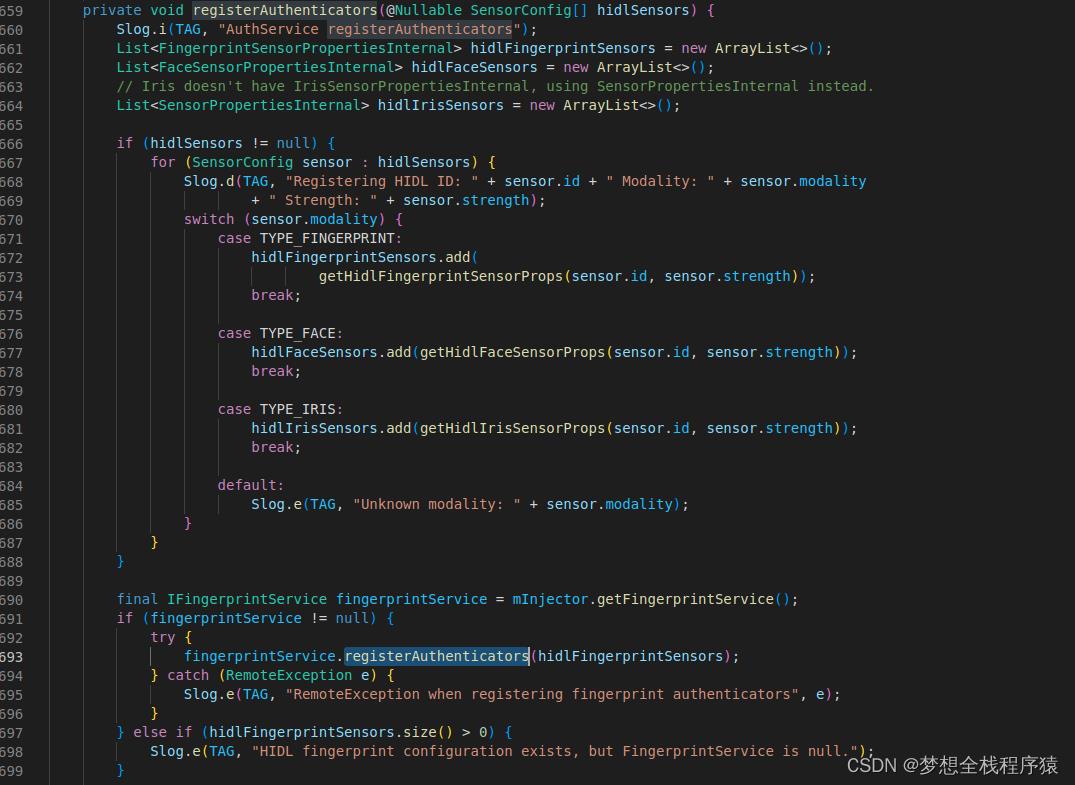
690到693行代码中,发现是IFingerprintService接口的实现类,调用了IFingerprintService接口的registerAuthenticators;可以从其中猜测,这个mInjector.getFingeprintService()获取到的是上面介绍的FingerprintServiceWrapper服务器做对应的客户端,所以通过registerAuthenticators方法,最终调用到了服务器端FingerprintServiceWrapper的registerAuthenticators方法;
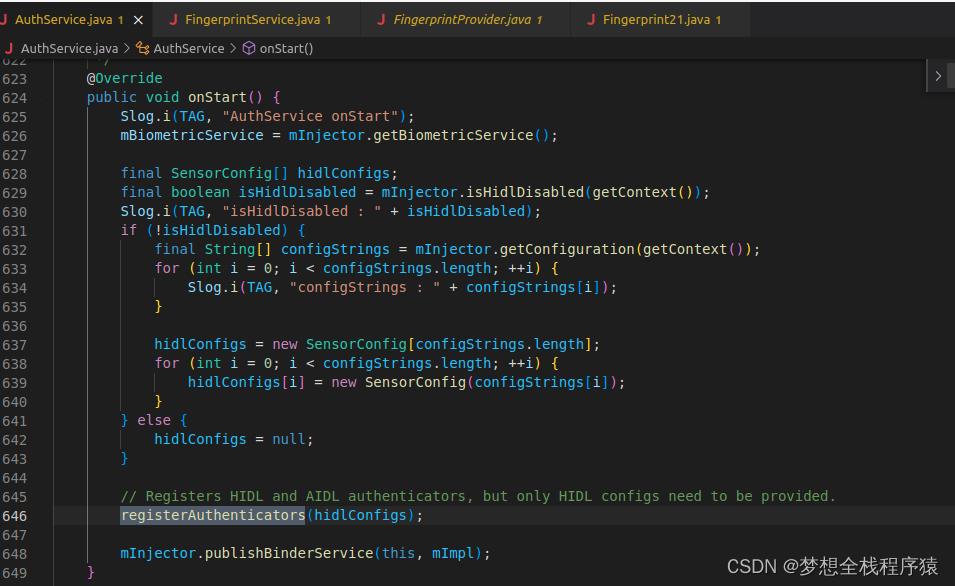
通过跟踪,发现AuthService的registerAuthenticators方法,是被其onStart方法调用的;所以现在的比较明朗,AuthService的onStart方法,也是因为AuthService被SystemServer调用而被调用的
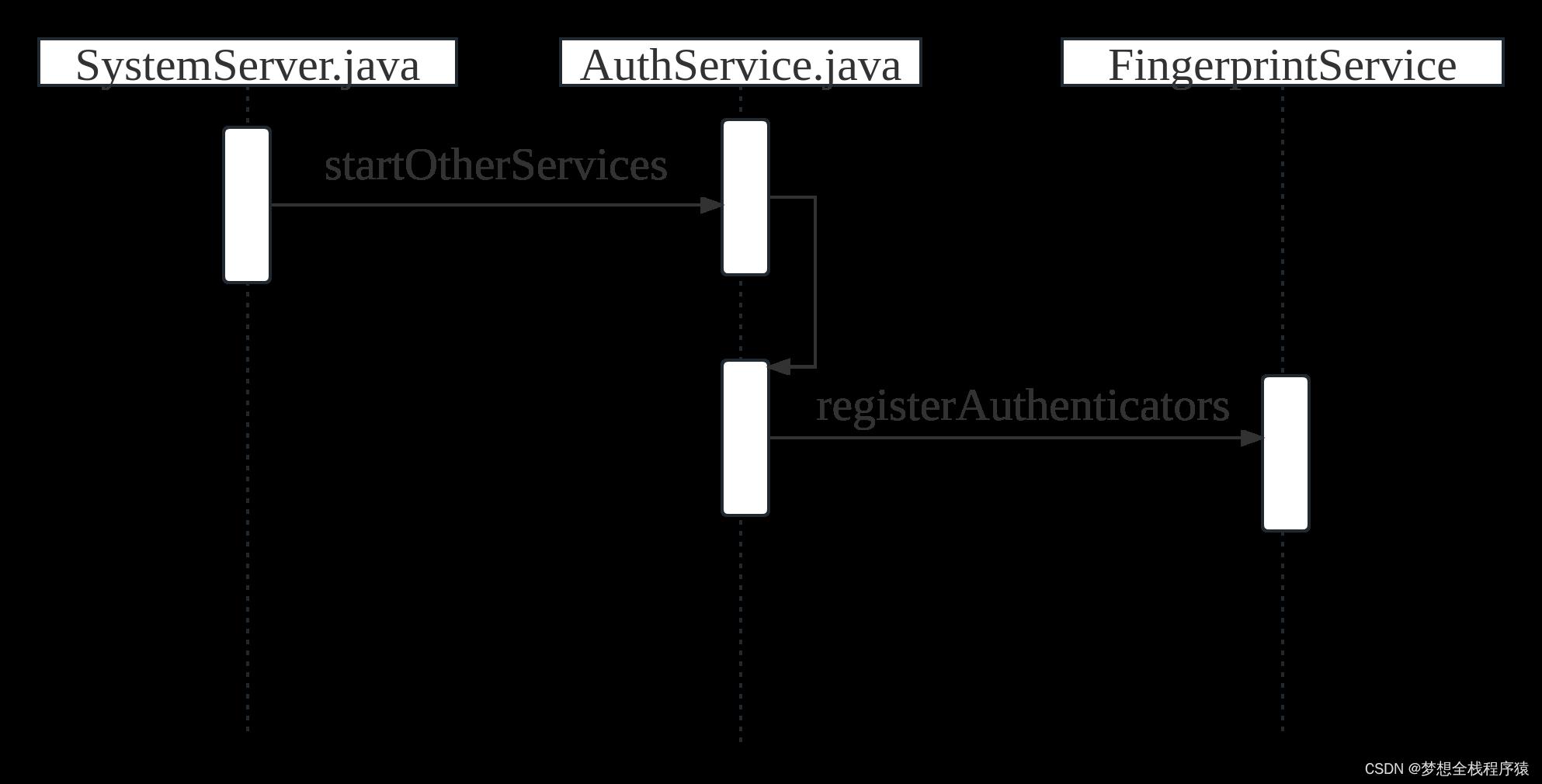
总结:
- SystemServer 调用AuthService的构造函数跟onStart方法
- AuthService在onStart方法中,调用了自己的registerAuthenticators方法,
通过获取FingerprintServiceWrapper服务器对应的客户端,调用了远程服务器
FingerprintServiceWrapper的registerAuthenticators函数
自定义View框架完全解析
前言
在Android中有很多的控件来供大家使用,但是和强大的IOS相比,Android所提供的控件平淡了许多,由于Android的开源可以让每个开发者都能创建自己的视图控件来满足自己的需求,正因为这样就出现各种各样的自定义控件,久而久之就形成了自定义视图框架。
这里介绍两种方法
1、给每一个需要配置自定义属性的子控件外面包裹一层自定义容器
2、自定义LayoutInflater将xml布局加载进来(实例化里面每一个控件,并且将控件里面的参数设置到控件类身上)
Part 1、子控件外面包裹一层自定义容器
效果~

功能分析:
外面一层为自定义ScrollView用来监听滑动,里面是一个容器,这里为什么要是自定义的呢?这里的自定义容器作用是为了动态的为每个View包裹一层容器,如果你不适用自定义的容器那你将要对每一个控件包裹一层自定义容器,这样便不能实现自定义View框架了。
接下来说一下具体的流程:
首先我们先定义一些自定义属性
<declare-styleable name="DiscrollView_LayoutParams">
<attr name="discrollve_alpha" format="boolean"/>
<attr name="discrollve_scaleX" format="boolean"/>
<attr name="discrollve_scaleY" format="boolean"/>
<attr name="discrollve_fromBgColor" format="color"/>
<attr name="discrollve_toBgColor" format="color"/>
<attr name="discrollve_translation"/>
<attr name="discrollve_rotate" format="integer"></attr>
</declare-styleable>
<attr name="discrollve_translation">
<flag name="fromTop" value="0x01"/>
<flag name="fromBottom" value="0x02"/>
<flag name="fromLeft" value="0x04"/>
<flag name="fromRight" value="0x08"/>
</attr><?xml version="1.0" encoding="utf-8"?>
<com.andly.administrator.andly_animframe.copydiscrollview.MyScrollView
xmlns:android="http://schemas.android.com/apk/res/android"
xmlns:tools="http://schemas.android.com/tools"
xmlns:discrollve="http://schemas.android.com/apk/res-auto"
android:id="@+id/activity_copy_main"
android:layout_width="match_parent"
android:layout_height="match_parent"
tools:context="com.andly.administrator.andly_animframe.copydiscrollview.CopyMainActivity">
<com.andly.administrator.andly_animframe.copydiscrollview.MyLinearLayout
android:layout_width="match_parent"
android:layout_height="match_parent">
<TextView
android:layout_width="match_parent"
android:layout_height="600dp"
android:background="@android:color/white"
android:textColor="@android:color/black"
android:textSize="25sp"
android:padding="25dp"
tools:visibility="gone"
android:gravity="center"
android:fontFamily="serif"
android:text="" />
<View
android:layout_width="match_parent"
android:layout_height="200dp"
discrollve:discrollve_fromBgColor="@android:color/holo_red_dark"
discrollve:discrollve_toBgColor="@android:color/holo_blue_dark"
/>
<ImageView
android:layout_width="200dp"
android:layout_height="150dp"
discrollve:discrollve_alpha="true"
discrollve:discrollve_translation="fromLeft|fromBottom"
android:src="@drawable/pic2" />
<TextView
android:layout_width="match_parent"
android:layout_height="wrap_content"
android:padding="20dp"
android:fontFamily="serif"
android:gravity="center"
android:text="眼见范冰冰与李晨在一起了,孩子会取名李冰冰;李冰冰唯有嫁给范伟,生个孩子叫范冰冰,方能扳回一城。"
android:textSize="23sp"
discrollve:discrollve_alpha="true"
discrollve:discrollve_translation="fromBottom" />
<ImageView
android:layout_width="wrap_content"
android:layout_height="wrap_content"
android:layout_margin="20dp"
android:layout_gravity="center"
android:src="@drawable/pic4"
discrollve:discrollve_scaleX="true"
discrollve:discrollve_scaleY="true" />
<ImageView
android:layout_width="wrap_content"
android:layout_height="wrap_content"
android:layout_margin="20dp"
android:layout_gravity="center"
android:src="@drawable/pic5"
discrollve:discrollve_translation="fromLeft|fromBottom"
discrollve:discrollve_rotate="360"/>
<ImageView
android:layout_width="wrap_content"
android:layout_height="wrap_content"
android:layout_margin="20dp"
android:layout_gravity="center"
android:src="@drawable/pic6"
discrollve:discrollve_translation="fromLeft|fromBottom"
/>
<ImageView
android:layout_width="wrap_content"
android:layout_height="wrap_content"
android:layout_margin="20dp"
android:layout_gravity="center"
android:src="@drawable/pic7"
discrollve:discrollve_translation="fromLeft|fromBottom"
/>
<ImageView
android:layout_width="wrap_content"
android:layout_height="wrap_content"
android:layout_margin="20dp"
android:layout_gravity="center"
android:src="@drawable/pic8"
discrollve:discrollve_translation="fromLeft|fromBottom"
/>
</com.andly.administrator.andly_animframe.copydiscrollview.MyLinearLayout>
</com.andly.administrator.andly_animframe.copydiscrollview.MyScrollView>接下来自定义LinearLayout,它的作用不光为每个控件包裹一层容器还需要将自定义属性传递给包裹的容器
@Override
public void addView(View child, int index, ViewGroup.LayoutParams params)
MyLayoutParams ps = (MyLayoutParams) params;
if (!isCustomValue(ps))
super.addView(child, index, params);
else
layout = new MyFramementLayout(getContext());
layout.setDiscrollve_alpha(ps.discrollve_alpha);
layout.setDiscrollve_scaleX(ps.discrollve_scaleX);
layout.setDiscrollve_scaleY(ps.discrollve_scaleY);
layout.setDiscrollve_fromBgColor(ps.discrollve_fromBgColor);
layout.setDiscrollve_toBgColor(ps.discrollve_toBgColor);
layout.setDiscrollve_translation(ps.discrollve_translation);
layout.setDiscrollve_rotate(ps.discrollve_rotate);
layout.addView(child);
super.addView(layout, index, params);
void rInflate(XmlPullParser parser, View parent, final AttributeSet attrs,
boolean finishInflate) throws XmlPullParserException, IOException
final int depth = parser.getDepth();
int type;
while (((type = parser.next()) != XmlPullParser.END_TAG ||
parser.getDepth() > depth) && type != XmlPullParser.END_DOCUMENT)
if (type != XmlPullParser.START_TAG)
continue;
final String name = parser.getName();
if (TAG_REQUEST_FOCUS.equals(name))
parseRequestFocus(parser, parent);
else if (TAG_INCLUDE.equals(name))
if (parser.getDepth() == 0)
throw new InflateException("<include /> cannot be the root element");
parseInclude(parser, parent, attrs);
else if (TAG_MERGE.equals(name))
throw new InflateException("<merge /> must be the root element");
else if (TAG_1995.equals(name))
final View view = new BlinkLayout(mContext, attrs);
final ViewGroup viewGroup = (ViewGroup) parent;
final ViewGroup.LayoutParams params = viewGroup.generateLayoutParams(attrs);
rInflate(parser, view, attrs, true);
viewGroup.addView(view, params);
else
final View view = createViewFromTag(parent, name, attrs);
final ViewGroup viewGroup = (ViewGroup) parent;
final ViewGroup.LayoutParams params = viewGroup.generateLayoutParams(attrs);
rInflate(parser, view, attrs, true);
viewGroup.addView(view, params);
if (finishInflate) parent.onFinishInflate();
@Override
public LayoutParams generateLayoutParams(AttributeSet attrs)
//解析xml
return new MyLayoutParams(this.getContext(), attrs);
@Override
public static class MyLayoutParams extends LinearLayout.LayoutParams
boolean discrollve_alpha;
boolean discrollve_scaleX;
boolean discrollve_scaleY;
int discrollve_fromBgColor;
int discrollve_toBgColor;
int discrollve_translation;
int discrollve_rotate;
public MyLayoutParams(Context c, AttributeSet attrs)
super(c, attrs);
TypedArray ta = c.obtainStyledAttributes(attrs, R.styleable.DiscrollView_LayoutParams);
discrollve_alpha = ta.getBoolean(R.styleable.DiscrollView_LayoutParams_discrollve_alpha, false);
discrollve_scaleX = ta.getBoolean(R.styleable.DiscrollView_LayoutParams_discrollve_scaleX, false);
discrollve_scaleY = ta.getBoolean(R.styleable.DiscrollView_LayoutParams_discrollve_scaleY, false);
discrollve_fromBgColor = ta.getInt(R.styleable.DiscrollView_LayoutParams_discrollve_fromBgColor, -1);
discrollve_toBgColor = ta.getInt(R.styleable.DiscrollView_LayoutParams_discrollve_toBgColor, -1);
discrollve_translation = ta.getInt(R.styleable.DiscrollView_LayoutParams_discrollve_translation, -1);
discrollve_rotate = ta.getInt(R.styleable.DiscrollView_LayoutParams_discrollve_rotate,-1);
ta.recycle();
@Override
public void scrollViews(float rate) //rate:0 - 1
if (discrollve_alpha)
setAlpha(rate);
if (discrollve_scaleX)
setScaleX(rate);
if (discrollve_scaleY)
setScaleY(rate);
if (isTranslation(TRANSLATION_FROM_TOP)) //从-height~0
setTranslationY(-mHeight * (1 - rate));
if (isTranslation(TRANSLATION_FROM_BOTTOM)) //从height~0
setTranslationY(mHeight * (1 - rate));
if (isTranslation(TRANSLATION_FROM_LEFT)) //-width~0
setTranslationX(-mWidth * (1 - rate));
if (isTranslation(TRANSLATION_FROM_RIGHT)) //width~0
setTranslationX(mWidth * (1 - rate));
if(discrollve_rotate != -1)
setRotation(discrollve_rotate*rate);
//颜色渐变
if (discrollve_fromBgColor != -1 && discrollve_toBgColor != -1)
setBackgroundColor((Integer) mEvaluator.evaluate(rate, discrollve_fromBgColor, discrollve_toBgColor));
@Override
protected void onScrollChanged(int l, int t, int oldl, int oldt)
super.onScrollChanged(l, t, oldl, oldt);
mHeight = getHeight();
for (int i = 0; i < mContent.getChildCount(); i++)
if (!(mContent.getChildAt(i) instanceof MyScrollViewInterface)) //这里过滤掉没有定义自定义属性的控件
continue;
MyScrollViewInterface viewInterface = (MyScrollViewInterface) mContent.getChildAt(i);
View view = mContent.getChildAt(i);//得到包裹的容器
int childHeight = view.getHeight();//包裹容器的高度
int childTop = view.getTop();
int absoluteTop = childTop - t;//包裹容器顶部到屏幕顶部
if(absoluteTop <= mHeight)
int childChangeHeight = mHeight - absoluteTop;//得到包裹容器未显示的高度
viewInterface.scrollViews(clamp(childChangeHeight / (float) childHeight, 1.0f, 0f));
private float clamp(float s, float max, float min)
return Math.max(Math.min(s, max), min);
Part 2、自定义LayoutInflater将xml布局加载进来
效果~

根据上面的源码分析继续进入便走到了LayoutInflater的createViewFromTag的方法
/*
* default visibility so the BridgeInflater can override it.
*/
View createViewFromTag(View parent, String name, AttributeSet attrs)
......
try
View view;
if (mFactory2 != null) view = mFactory2.onCreateView(parent, name, mContext, attrs);
else if (mFactory != null) view = mFactory.onCreateView(name, mContext, attrs);
else view = null;
if (view == null && mPrivateFactory != null)
view = mPrivateFactory.onCreateView(parent, name, mContext, attrs);
//(2)
if (view == null)
if (-1 == name.indexOf('.'))
view = onCreateView(parent, name, attrs);
else
view = createView(name, null, attrs);
if (DEBUG) System.out.println("Created view is: " + view);
return view;
......
通过上面的代码不难想象我们可以自定义LayoutInflater类传入一个自定义的Factory类,然后在自定义的Factory类onCreateView方法里面获取到每个子View的属性,但值得注意的是通过这种方法来实现的话,需要实现(2)下面代码
首先我们先定义自定义属性
<attr name="a_in" format="float" />
<attr name="a_out" format="float" />
<attr name="x_in" format="float" />
<attr name="x_out" format="float" />
<attr name="y_in" format="float" />
<attr name="y_out" format="float" />public class ParallaxLayoutInflater extends LayoutInflater
private ParallaxFragment fragment;
protected ParallaxLayoutInflater(LayoutInflater original, Context newContext,ParallaxFragment fragment)
super(original, newContext);
this.fragment = fragment;
//重新设置布局加载器的工厂
//工厂:创建布局文件中所有的视图
setFactory(new ParallaxFactory(this));
@Override
public LayoutInflater cloneInContext(Context newContext)
return new ParallaxLayoutInflater(this,newContext,fragment);
class ParallaxFactory implements LayoutInflater.Factory
private LayoutInflater inflater;
private final String[] sClassPrefix =
"android.widget.",
"android.view."
;
public ParallaxFactory(LayoutInflater inflater)
this.inflater = inflater;
@Override
public View onCreateView(String name, Context context,AttributeSet attrs)
View view = null;
if (view == null)
view = createViewOrFailQuietly(name,context,attrs);//创建View的过程
if (view != null)
setViewTag(view,context,attrs);//获取自定义的属性,通过相应的标签关联到视图上
fragment.getParallaxViews().add(view);
return view;
1、在onCreateView方法中创建View
private View createViewOrFailQuietly(String name, String prefix,Context context,AttributeSet attrs)
try
return inflater.createView(name, prefix, attrs);//通过系统的Inflater来创建视图
catch (Exception e)
return null;
private View createViewOrFailQuietly(String name, Context context,AttributeSet attrs)
if (name.contains(".")) //自定义控件将前缀设置为空
createViewOrFailQuietly(name, null, context, attrs);
for (String prefix : sClassPrefix) //系统视图,这里通过对每个前缀都进行遍历判空来判断是否为真正的前缀
View view = createViewOrFailQuietly(name, prefix, context, attrs);
if (view != null)
return view;
return null;
private void setViewTag(View view, Context context, AttributeSet attrs)
int[] attrIds =
R.attr.a_in,
R.attr.a_out,
R.attr.x_in,
R.attr.x_out,
R.attr.y_in,
R.attr.y_out;
TypedArray a = context.obtainStyledAttributes(attrs, attrIds);
if (a != null && a.length() > 0)
ParallaxViewTag tag = new ParallaxViewTag();
tag.alphaIn = a.getFloat(0, 0f);
tag.alphaOut = a.getFloat(1, 0f);
tag.xIn = a.getFloat(2, 0f);
tag.xOut = a.getFloat(3, 0f);
tag.yIn = a.getFloat(4, 0f);
tag.yOut = a.getFloat(5, 0f);
view.setTag(R.id.parallax_view_tag,tag);
a.recycle();
@Override
public void onPageScrolled(int position, float positionOffset,
int positionOffsetPixels)
this.containerWidth = getWidth();
//获取到进入的页面
ParallaxFragment inFragment = null;
try
inFragment = fragments.get(position - 1);
catch (Exception e)
//获取到退出的页面
ParallaxFragment outFragment = null;
try
outFragment = fragments.get(position);
catch (Exception e)
if (inFragment != null)
List<View> inViews = inFragment.getParallaxViews();//获取到Fragment上的所有视图,实现动画效果
if (inViews != null)
for (View view : inViews)
ParallaxViewTag tag = (ParallaxViewTag) view.getTag(R.id.parallax_view_tag);//获取标签,从标签中获取所有动画的参数
if (tag == null) //tag为空的时候没有设置自定义属性
continue;
ViewHelper.setTranslationY(view, (containerWidth - positionOffsetPixels) * tag.yIn);
ViewHelper.setTranslationX(view, (containerWidth - positionOffsetPixels) * tag.xIn);
if(outFragment != null)
List<View> outViews = outFragment.getParallaxViews();
if (outViews != null)
for (View view : outViews)
ParallaxViewTag tag = (ParallaxViewTag) view.getTag(R.id.parallax_view_tag);
if (tag == null)
continue;
ViewHelper.setTranslationY(view, 0 - positionOffsetPixels * tag.yOut);
ViewHelper.setTranslationX(view, 0 - positionOffsetPixels * tag.xOut);
@Override
public void onPageSelected(int position)
if (position == adapter.getCount() - 1)
iv_man.setVisibility(INVISIBLE);
else
iv_man.setVisibility(VISIBLE);
@Override
public void onPageScrollStateChanged(int state)
AnimationDrawable animation = (AnimationDrawable) iv_man.getBackground();
switch (state)
case ViewPager.SCROLL_STATE_DRAGGING:
animation.start();
break;
case ViewPager.SCROLL_STATE_IDLE:
animation.stop();
break;
default:
break;
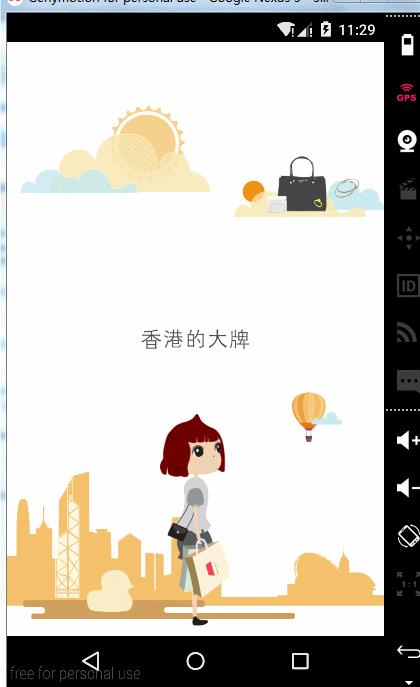
以上是关于Android12指纹框架完全解析的主要内容,如果未能解决你的问题,请参考以下文章
Android 开源框架Universal-Image-Loader完全解析--- 图片缓存策略详解
Android Kotlin Jetpack Compose UI框架 完全解析